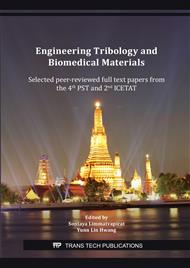p.9
p.16
p.22
p.28
p.35
p.40
p.48
p.55
p.61
Development of Nifedipine Amorphous Solid Dispersion Composed of Surface-Active Agents
Abstract:
The amorphous solid dispersions (ASDs) containing amino methacrylate copolymer and surface-active agents were prepared to improve the nifedipine (NDP) dissolution. The different types of surface-active agent i.e., polysorbates 80, sodium lauryl sulfate (SLS) and polyethylene glycol (PEG) 400 were used. In order to evaluate the ASDs formulation,powder X-ray diffractometry and thermal analysis to characterize NDP crystallinity in ASDs and the dissolution study of NDP have been performed to compare the dissolution profiles. The ASDs were kept for 6 months to investigate the stability. In the X-ray diffraction pattern, no peak was observed in all samples of ASDs. No peak was found in sample of all ASDs from the thermograms. These results suggest that the drug may be molecularly dispersed in matrix of amino methacrylate copolymer. The drug dissolution at 120 min, from ASDs without surface-active agent and NDP powder were 58.31% and 17.95%, respectively. The dissolved NDP from ASDs composed of SLS, polysorbate 80 and PEG400 were 96.25%, 88.86% and 75.32%, respectively. These results may occur due to the reduction of surface tension, the addition of the low amount of high efficiency of surface-active agent e.g., SLS (compared with PEG400 and polysorbate 80) provided the higher NDP dissolution. The content analysis of NDP in selected ASDs was studied at the end of 3 and 6 months, the NDP content remained unchanged after storage.
Info:
Periodical:
Pages:
35-39
Citation:
Online since:
October 2021
Authors:
Price:
Сopyright:
© 2021 Trans Tech Publications Ltd. All Rights Reserved
Share:
Citation:


